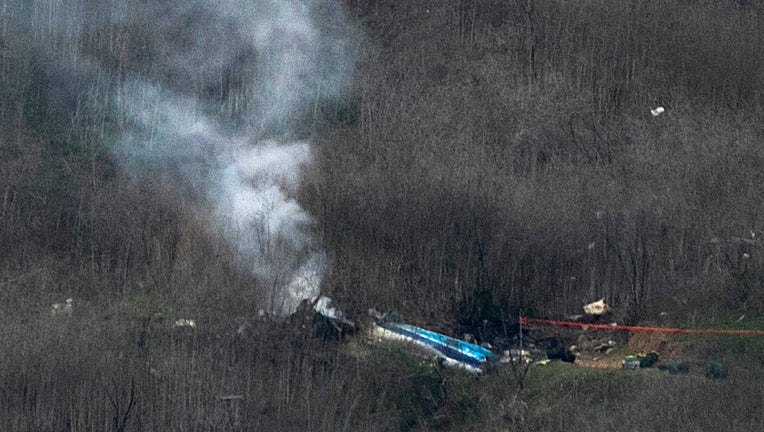Pilot in Kobe Bryant crash was just seconds from getting out of the clouds and being able to see

Wreckage of the crashed helicopter that was carrying former NBA star Kobe Bryant, his 13-year-old daughter Gianna and seven others smolders on the ground on January 26, 2020 in Calabasas, California.
LOS ANGELES - The pilot of the helicopter that crashed and killed Kobe Bryant and eight others was almost out of blinding clouds when he suddenly plunged and crashed into a Southern California hillside, investigators and aviation experts indicated.
Ara Zobayan had told air traffic control he was climbing to 4,000 feet (1,219 meters) and he rose to 2,300 feet (701 meters), according to an investigative update released Friday from the National Transportation Safety Board.
The helicopter was just 100 feet (30 meters) from the cloud tops and conceivably would have broken through into clear air in a matter of seconds. Air traffic controllers had advised Zobayan that the cloud tops were at 2,400 feet (731.5 meters.) Camera footage later reviewed by the NTSB showed nearby clouds at that estimated height.
The NTSB update didn't make any conclusion about what caused the Jan. 26 crash in Calabasas, northwest of Los Angeles, because the investigation remains underway and a final report isn't expected for a year or so. However, the update did say there was no sign of mechanical failure based on wreckage examined by experts at the scene.
Investigators also believe that since a tree branch at the crash site was cut, the twin engines were working and the rotors turning at the time of impact. All four of the helicopter's blades had similar damage, the update stated.
An unidentified witness told the NTSB the hillside where the crash occurred was shrouded in mist when he heard the helicopter approaching. It sounded normal and he then saw the blue-and-white aircraft emerge from the fog moving forward and down. It started to roll to the left, and he caught a glimpse of the aircraft's belly. Within 2 seconds, it slammed into the hillside just below him.
Veteran pilots have suggested that Zobayan became disoriented in the thick atmosphere.
The pilot's last maneuvers suggest he tried to pop up above the clouds, and he did ascend for perhaps a minute before turning left, said Mike Sagely, a helicopter pilot in the Los Angeles area with 35 years of flying experience.
When pilots inadvertently enter clouds and try to turn instead of still ascending, "probably in the neighborhood of 80 to 90 percent of the time, it's catastrophic," Sagely said. "When he went into the clouds, he had a full-on emergency," Sagely said.
The helicopter was descending at 4,000 feet (1,219 meters) per minute and slammed into the hillside at more than 180 mph (290 kph).
Air safety consultant Kipp Lau said the speed of the aircraft's descent indicated "you've certainly lost control of the aircraft."
The crash occurred as Bryant and the other passengers were flying from Orange County to Ventura County to attend a girls basketball tournament at Bryant's Mamba Sports Academy. He coached his 13-year-old daughter Gianna's team. She and two teammates died.
A public memorial for Bryant and the other victims is scheduled for Feb. 24 at the Staples Center, where Bryant starred for the Lakers. The date 2/24 corresponds with the No. 24 jersey he wore and the No. 2 worn by Gianna.
Zobayan was a regular pilot for Bryant and the chief pilot for Island Express Helicopters, with more than 8,200 hours of flight time. He was certified to fly solely using instruments -- a more difficult rating to attain that allows pilots to fly at night and through clouds when the ground isn't visible -- and was a pilot to other celebrities including Los Angeles Clippers star Kawhi Leonard and Kylie Jenner.
During the flight with Bryant's group, Zobayan did not report any equipment problems and sounded calm while communicating to air traffic controllers. His final transmission said he was going to climb above the clouds. Eight seconds after reaching peak altitude, he started the fateful descent.
Former Island Express pilot Kurt Deetz, who regularly flew Bryant to games at the Staples Center, said reading the NTSB's report reinforced how dangerously fast the helicopter was traveling in conditions that had prompted the Los Angeles Police Department and the Los Angeles County Sheriff's Department to ground their smaller copters.
"Normally in those conditions, you're pretty cautious. You're proceeding slowly," Deetz said.
The impact tore the helicopter apart. All aboard died from blunt force trauma.
The 50-year-old Zobayan's most recent flight review included training on inadvertently flying into bad weather conditions. It covered how to recover if the aircraft's nose is pointed too far up or down and what to do if the helicopter banks severely to one side. He earned satisfactory grades in the review, which took place in May 2019.
Deetz said Zobayan previously had told him that he did not have actual experience flying in clouds, despite being certified. Deetz said that isn't uncommon.
Bryant's helicopter did not have a device called the Terrain Awareness and Warning System, known as TAWS, that signals when an aircraft is in danger of hitting ground. The NTSB has recommended the system be mandatory for helicopters, but the Federal Aviation Administration only requires it for air ambulances. U.S. Sen. Dianne Feinstein and Rep. Brad Sherman, both California Democrats, have called for the FAA to mandate the devices.
The others killed included Orange Coast College baseball coach John Altobelli, his wife, Keri and daughter Alyssa; Bryant's friend and assistant coach, Christina Mauser; and Sarah Chester and her daughter Payton, 14. A public memorial for the Altobelli family will be held Monday at Angel Stadium in Anaheim.

